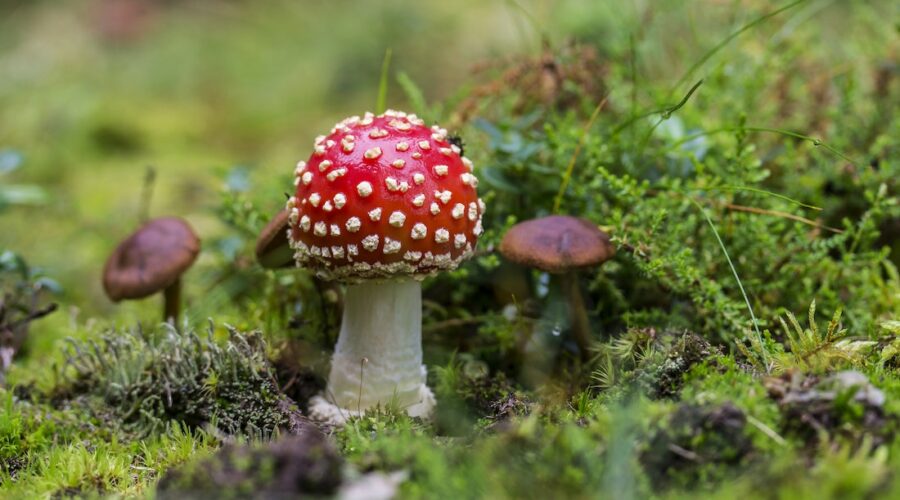Amanita Muscaria – Dosages, Effects and Legality of The Christmas Mushroom
Amanita Muscaria, also known as the Christmas mushroom (also known as fly agaric, the Super Mario mushroom, or the toadstool mushroom) is an iconic mushroom and a natural psychedelic. Recognizable for its bright red cap with white spots, it has become closely associated with Christmas.
This connection is worth exploring, as are the many varied aspects of Amanita muscaria, including its religious use, effects, and legality.
RELATED: What Are Magic Mushroom Spores, And Are They Legal?
The Iconic Amanita Muscaria
To begin with, let’s describe the appearance of the Christmas mushroom in more detail. It can grow to 20cm across and 30cm tall and has a savory smell.
- Cap: Scarlet or orange color, sometimes with white wart-like spots.
- Gills: White to cream colored, located under the cap. The gills are closely packed and not joined to the stem.
- Stipe: The stipe (or stalk) is white with a brittle texture. The base has a bulbous volva (the cup-like base from which the stem emerges) with shaggy rings of scales around it and a large skirt.
- Spores: White and oval
There is a similar-looking mushroom (the blusher: Amanita rubescens), which some may confuse with amanita muscaria. The blusher has a similar shape, with a pale, reddish-brown cap and cream spots.
Microdosing to help with sleep or anxiety: Calm is the first legal and natural Amanita muscaria-based microdosing product to help with both. Buy it here!
Where And When Amanita Muscaria Grows
The amanita muscaria is native to conifer and deciduous woodlands of the temperate and boreal regions of the northern hemisphere. It grows in the following regions.
- Europe
- Northern Asia
- North and Central America
Its range extends from the northern half of Alaska and northern Scandinavia, Russia, and Japan southwards to mountainous areas of Costa Rica and the Hindu Kush mountain range between central Afghanistan and northern Pakistan.
You can also find fly agaric in Australia, New Zealand, South Africa, and South America. The mushroom is not native to those regions, but is often moving into the southern hemisphere via travelers.
You will typically find the Christmas mushroom growing beneath many types of trees, including pine, oak, spruce, fir, birch, and cedar.
The colorful fruiting bodies can typically be seen between late summer and early winter — the end of August to the end of December.
RELATED: What Are Golden Teachers Mushrooms, And Are They Legal?
What Causes Amanita Muscaria’s Effects?
| Component | Description | Psychoactive Effect |
| Ibotenic acid | A water-soluble amino acid that is converted to muscimol during drying or heating | Sedative, hypnotic, and psychoactive effects |
| Muscimol | A potent psychoactive substance that activates GABA receptors in the brain | Hallucinations, altered perception, and euphoria |
| Muscarine (NOTE: This is removed in all high-quality Amanita muscaria-based OTC products, but is the reason for its reputation for causing sickness.) | A poisonous alkaloid that causes cholinergic symptoms such as sweating, salivation, and lacrimation | Not psychoactive, but can cause poisoning symptoms |
What’s is a Recommended Amanita Muscaria Dose?
Amanita muscaria is one of the harder mushrooms to figure out how to dose. Its potency can vary greatly depending on the time of the year, the amount of rain that has occurred recently, the altitude it was grown and many other factors. The best bet is to start very low and work your way up. But it’s important to note: Each batch of Amanita muscaria is different. So if your harvests can vary from week to week. Treat each harvest as its own unique mushroom with it’s own unique potency potential.
But first, let’s breakdown the typical sizes of the Amanita muscaria mushroom caps so you can understand what the dosage recommendations really mean. Note: all of these are for fresh and not dried Amanita muscaria mushroom caps:
| Size of Cap | Cap Diameter | Cap Weight |
| Small | 5-10 cm (2-4 inches) | 10-50 grams (0.35-1.75 ounces) |
| Medium | 10-15 cm (4-6 inches) | 50-100 grams (1.75-3.5 ounces) |
| Large | 15-25 cm (6-10 inches) | 100-250 grams (3.5-9 ounces) |
But here’s a general guideline for Amanita muscaria dosages by size and weight:
Low Dose: One small-to-mid-sized mushroom cap or 25-75 grams.
Medium Dose: Two-to-Three medium-sized caps or 75-150 grams.
Large Dose: One large and one medium sized cap or 200-300 grams.
Again, it’s important to note that consuming Amanita muscaria mushrooms can be dangerous and should be done with caution, if at all.
RELATED: Do Dosages of Psychedelics Differ for Anxiety, Depression, Pain and PTSD?
The Use Of Amanita Muscaria In Siberia
Many of the indigenous peoples of Siberia traditionally use fly agaric as an entheogen. In western Siberia, the use of this psychedelic mushroom was restricted to shamans. These people use it as an alternative way of entering a trance state (normally, they would achieve trance states through prolonged drumming and dancing). In eastern Siberia, both shamans and laypeople used fly agaric, both religiously and recreationally.
The shaman in eastern Siberia would consume the amanita muscaria, and then others would drink his urine. This urine still contained psychoactive compounds from the mushrooms. It was observed that consuming the urine led to stronger psychoactive effects with fewer negative effects (as the toxic elements of the mushroom would have been filtered out by the body).
Among the Koryak people of eastern Siberia, reports claim that local reindeer often follow an individual who is intoxicated by fly agaric. If that individual then urinated in the snow, the reindeer would consume that snow and likewise become intoxicated. The Koryak people could use the inebriated state of the reindeer to more easily rope and hunt them.
A Theory On The Role Of Fly Agaric In Hinduism
R. Gordon Wasson, the former Vice President for Public Relations at J.P. Morgan, was famed for traveling to Mexico and perhaps being one of the first Westerners to participate in a Mazatec psilocybin mushroom ritual. He participated in the ritual with María Sabina, a well-known curandera (traditional native healer/shaman).
He wrote an article about his travels and mushroom experience, titled “Seeking the Magic Mushroom”, published in Life magazine in 1957. This article introduced psychedelic mushrooms to a mainstream audience for the first time.
Since that experience in Mexico, Wasson continued to write about psychedelic mushrooms. Wasson would eventually turn his attention to soma, a ritual drink described in the Vedas, the most ancient religious texts belonging to Hinduism. In his book Soma: Divine Mushroom of Humanity (1967), Wasson hypothesized that soma was based on the fly agaric mushroom. He tried to draw parallels between Vedic description of the effects of soma and reports of the Siberian uses of the mushroom.
This theory attracted supporters and detractors. Alternative candidates for soma include Sarcostemma acidum, Psilocybe cubensis (proposed by Terence McKenna in Food of the Gods), Peganum harmala (Syrian rue), and Ephedra sinica.
Fly Agaric And The Myth Of Santa Claus
Several authors and academics have proposed that the consumption of Amanita Muscaria is responsible for the Santa Claus myth as we know it today. These include the below.
- John Rush, an anthropologist at Sierra College in Rocklin, California
- James Arthur, the author of Mushrooms and Mankind (2003)
- Carl Ruck, a professor of classics at Boston University
- Donald Pfister, a Harvard University biologist who studies fungi
The connections they make between the amanita muscaria and Santa and his flying reindeer are the following.
- Siberian shamans would drop into locals’ teepee-like homes with a bag full of fly agaric mushrooms as presents in late December. They would enter through the roof because the snow was usually blocking the doors.
- Fly agaric mushrooms, like Christmas presents, are beneath pine trees.
- Siberian people who ingested fly agaric may have hallucinated that reindeer nearby were flying.
- Siberian shamans have a tradition of dressing up like the toadstool mushroom, wearing red suits with white spots.
- You can find the iconic toadstool mushroom in Christmas decorations throughout the world, particularly in Scandinavia and northern Europe.
- Santa lives in the North Pole.
However, others have argued the mushroom-Santa connection is flawed. For example, this is from historian Ronald Hutton:
“If you look at the evidence of Siberian shamanism, which I’ve done, you find that shamans didn’t travel by sleigh, didn’t usually deal with reindeer spirits, very rarely took the mushrooms to get trances, didn’t have red-and-white clothes.”
RELATED: How To Grow Psilocybin Mushrooms In Your Own Home
The Symbolism Of Fly Agaric
Whether or not the amanita muscaria mushroom-Santa connection is true, fly agaric still finds a close association with Christmas. You can find depictions of the mushroom in many historic prints of Christmas cards.
The toadstool also features in many fairy tale stories, as well as the story of Alice in Wonderland, where Alice is given some fly agaric to eat. The mushroom is iconic in the Super Mario games, with two of the Super Mushroom power-up items being based on it. Another famous use of the mushroom is in the dancing mushroom sequence in the 1940 Disney film Fantasia.
In addition, it is common for garden ornaments and children’s picture books to depict gnomes and fairies using fly agaric mushrooms as seats or homes.
The Effects Of Consuming Amanita Muscaria
The Christmas mushroom has psychedelic effects. However, these are not like the effects you get from ingesting psilocybin mushrooms. This is because the psychoactive compounds found in fly agaric are not psilocybin and psilocin but muscimol and ibotenic acid. These chemicals are also toxins, so they can have a negative effect on the body.
Fly agaric often presents unpredictable effects. Consuming the amanita muscaria may lead to the following.
- Nausea
- Twitching
- Drowsiness
- Low blood pressure
- Sweating
- Salivation
- Auditory and visual distortions (e.g. macropsia: objects appearing larger than normal, and micropsia: objects appearing smaller than normal)
- Mood changes
- Euphoria
- Relaxation
- Depressant effects
- Sedative-hypnotic effects
- Dissociative effects
- Ataxia (a lack of voluntary coordination of muscle movements, and may include abnormalities in your gait, speech, and eye movements)
- Loss of equilibrium
In case of serious poisoning, the mushroom can cause delirium, marked by agitation, confusion, hallucinations, irritability, and central nervous system depression. In severe poisonings, seizures and comas may result.
RELATED: Can You Smoke Shrooms?
So What’s An Amanita Muscaria Experience Like?
A trip with fly agaric will last 6-8 hours. However, you shouldn’t expect a psychedelic experience like you would have after consuming psilocybin mushrooms. The quality of the trip will be different and probably not as psychedelic in terms of perceptual, emotional, and cognitive changes. Many users say it has more of a dreamy effect, and users tend to report that it is harder to achieve a psychedelic state with this mushroom.
Also, if you decide to embark on a psychedelic journey with fly agaric, there may be some unpleasant, physical side effects, which makes sense since the psychoactive compounds are also toxins.
The rural inhabitants of Sanada Town in Japan, however, have used techniques for detoxifying these mushrooms (without drinking the urine of those who have consumed them). They will then eat the mushroom as a local delicacy (although the detoxifying methods they use remove the hallucinogenic compounds).
Is Amanita Muscaria Legal?
The legal status of the amanita muscaria tends to differ from that of psilocybin mushrooms. Amanita Muscaria is legal in most countries, including the United States (except for in Louisiana, where you can only have the mushrooms for ornamental purposes). The main active compound, muscimol, is not considered a controlled substance in most countries.
There are a few countries where the possession, sale, transport, and cultivation of psychoactive amanita mushrooms are illegal. These include the below.
- Australia
- Romania
- The Netherlands
- Thailand
It is possible to find fly agaric mushrooms sold in headshops in countries where they’re legal. But since they grow naturally all over the world — and can be legally grown in most countries — you can source these mushrooms for yourself. It’s vital to keep in mind that if you want a reliable and healing psychedelic journey, free from physical discomfort as much as possible, then fly agaric may not be the right option for you.
Similar to those using penis envy mushrooms, experiences with the Christmas mushroom are often unique and valuable.



